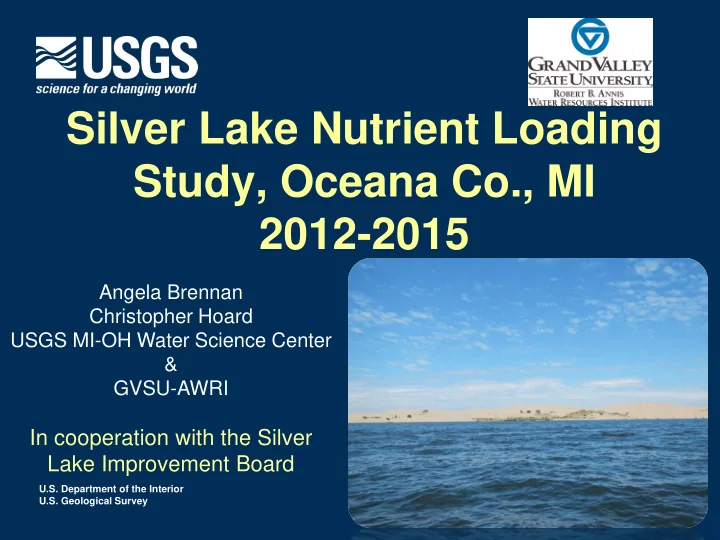

Silver Lake Nutrient Loading Study, Oceana Co., MI 2012-2015 Angela Brennan Christopher Hoard USGS MI-OH Water Science Center & GVSU-AWRI In cooperation with the Silver Lake Improvement Board U.S. Department of the Interior U.S. Geological Survey
Project Problem In 2011, Progressive AE published the “Silver Lake 2011 Water Quality Monitoring Report” Study results indicated Silver Lake appeared to be undergoing more accelerated eutrophication and if the trend continued, that there would be more frequent and prolonged algal blooms, reduced transparency, and a decline in overall water quality.
Project Objectives Describe current water quality in the lake, groundwater, tributaries, and atmosphere Quantify the water and nutrient budgets for Silver Lake and estimate the contribution of septic systems Identify the nutrient(s) limiting algal growth in Silver Lake Present model scenarios of future lake conditions in response to changes in nutrient loading inputs
Silver Lake, Oceana County, MI
Approach Monitor surface water flow & establish a water budget Water chemistry: Monitoring lake and stream chemistry 4 times per year for 2 years, plus 2-3 storm events (annually) 5 monitoring locations on lake Water temp, DO, Conductivity, pH Secchi disc transparency Chlorophyll- a , phytoplankton, N, P (surface & bottom)
Approach cont… Monitor groundwater influence: 4 wells, measure GW levels & nutrient chemistry for 2 years (North, South, East, & West) Observe groundwater flow by installing seepage meters Measure drainage tiles for N & P (38 tiles)
Approach cont… Precipitation Wet (rain and snow) & dry (several days following no precip) samples to determine atmospheric nutrient deposition (N and P) Nutrient inputs from lawn runoff and waterfowl Estimated from previously published literature values
Approach cont… Identify nutrient controlling algal blooms (AWRI) Nutrient bioassay, algal ID (cyanotoxins) Internal nutrient loading estimates (AWRI), determine flux of P & N from sediments 2 sites, oxic & anoxic treatments
Project results – Trophic Status Trophic status of Silver Lake, Oceana County, Michigan, based on Carlson’s Trophic State Index. (TSI, trophic state index; less than 40 represents oligotrophic conditions, 40-50 mesotrophic, greater than 50 represents eutrophic conditions).
Project results – Nutrient concentrations
Project results Concluded that internal loading is not a major source of P to Silver Lake Algal growth appears to be co-limited by P and N Cyanotoxin levels are not an issue to date
Project Results – Nutrient Loading
Predicting future lake conditions Nutrient adjustment scenarios of phosphorus and nitrogen to Silver Lake were processed using the BATHTUB model.
USGS Scientific Investigations Report 2015-5158 Prepared in cooperation with the Silver Lake Improvement Board Angela K. Brennan, Christopher J. Hoard, Joseph W. Duris, Mary E. Ogdahl, and Alan D. Steinman https://pubs.er.usgs.gov/ publication/sir20155158
Thank you!
Silver Lake Nutrient Loading Study, Oceana Co., MI: 2012-2014 Recommendations U.S. Department of the Interior U.S. Geological Survey
Summary Point #1 Both nitrogen and phosphorus co-limit algal growth
Nutrient Bioassay: July 2013
Recommendation #1 Need to reduce only N or P to limit algal growth, but limiting both will reduce size and severity of algal blooms
Summary Point #2 The current algal blooms do not have concentrations of toxins
Microcystin Concentration Silver Lake Site Date Concentration (µg/L) 1 (surface) 4/17/14 <0.05 2 (surface) <0.05 1 (surface) 5/2/14 <0.10 2 (surface) <0.05
Recommendation #2 Blooms should be tested for cyanotoxins, but 2013- 2014 data indicate very low toxicity
Summary Point #3 Sources of N and P 1) are not always the same, and 2) differ over time
GW is largest contributor of P on annual basis (47%)
Hunter Creek is largest contributor of N on annual basis (56%)
P in the GW: - relatively constant - highest in summer
N in the GW: - Very variable - Highest in summer
Recommendation #3 P Control: Focus first on groundwater; second on Hunter Cr. N Control: Focus first on Hunter Creek; second on summer GW
Summary Point #4a (P) Almost 1/3 of the P in groundwater is associated with septage
GW Hunter Cr.
Recommendation #4a Replace septic systems with sanitary sewers…
Summary Point #4b (P) Septic inputs vary around Silver Lake
Estimated TP Loading (lb/yr) GW Septic Location North Quadrant 12 6 South Quadrant 403 193 East Quadrant 15 7 West Quadrant 132 63 North Drain Tiles 68 33 Hunter Creek 385 86 TOTAL 630 388
Recommendation #4b If funding is a limitation, prioritize regions with highest P loads and bioavailable P
Summary Point #5 (N) Hunter Creek and summer groundwater main sources of N
Recommendation #5 Identify source of N to Hunter Creek
Recommend
More recommend